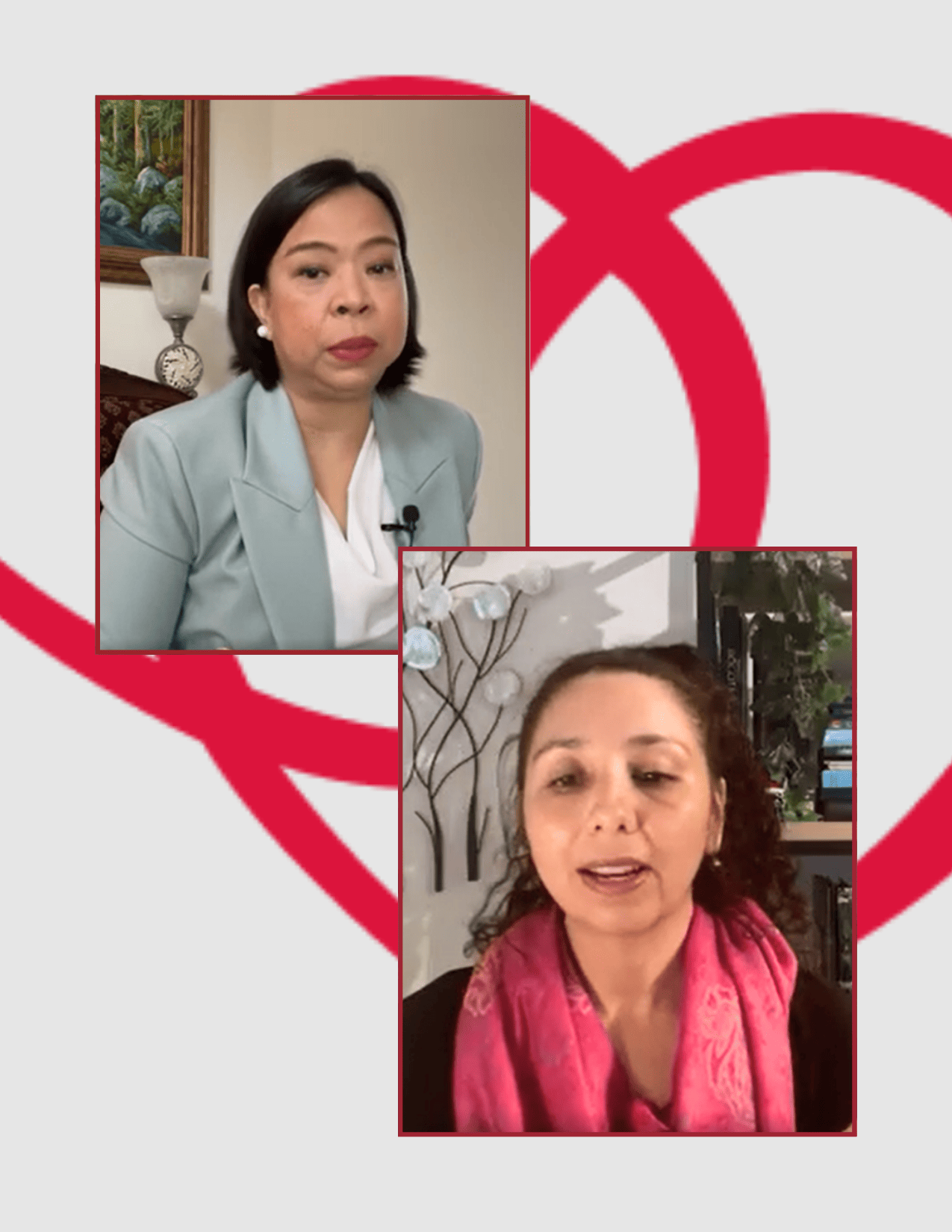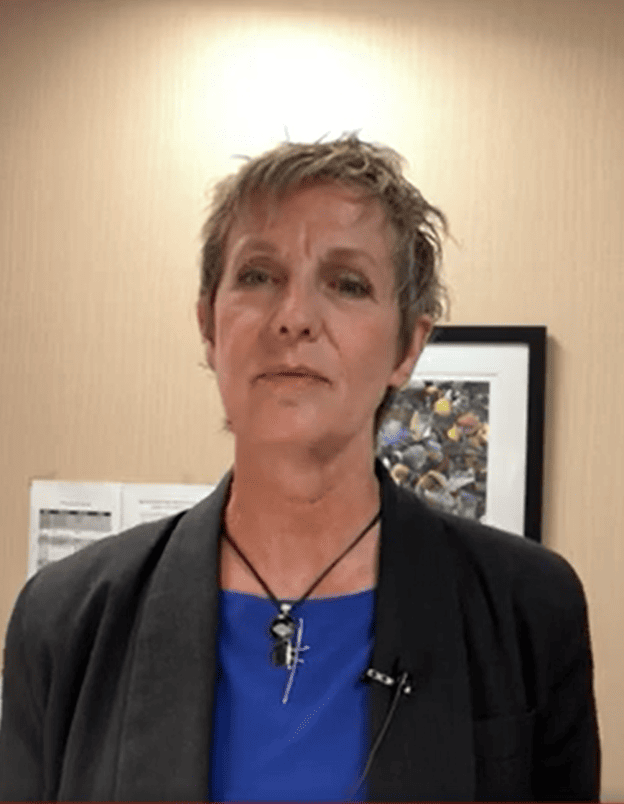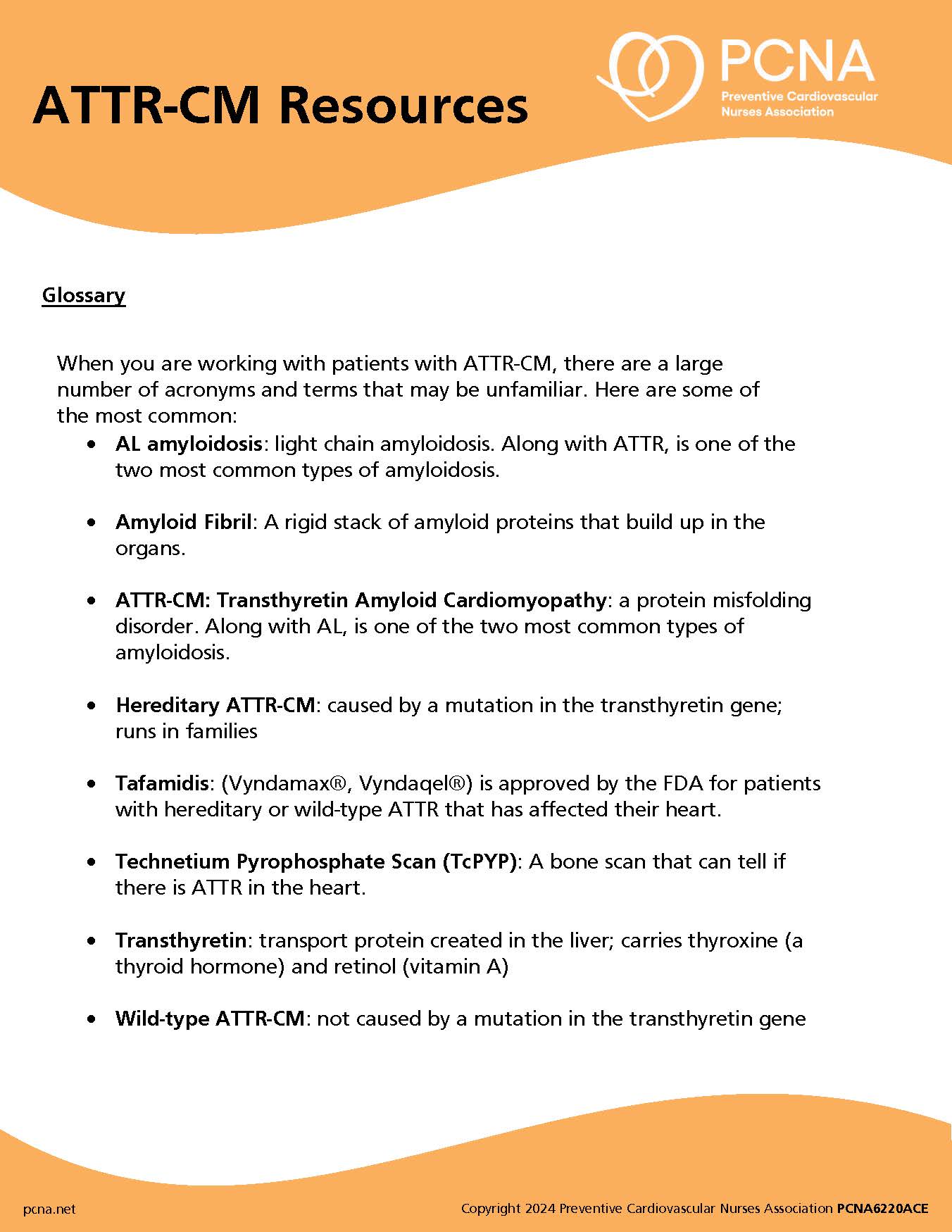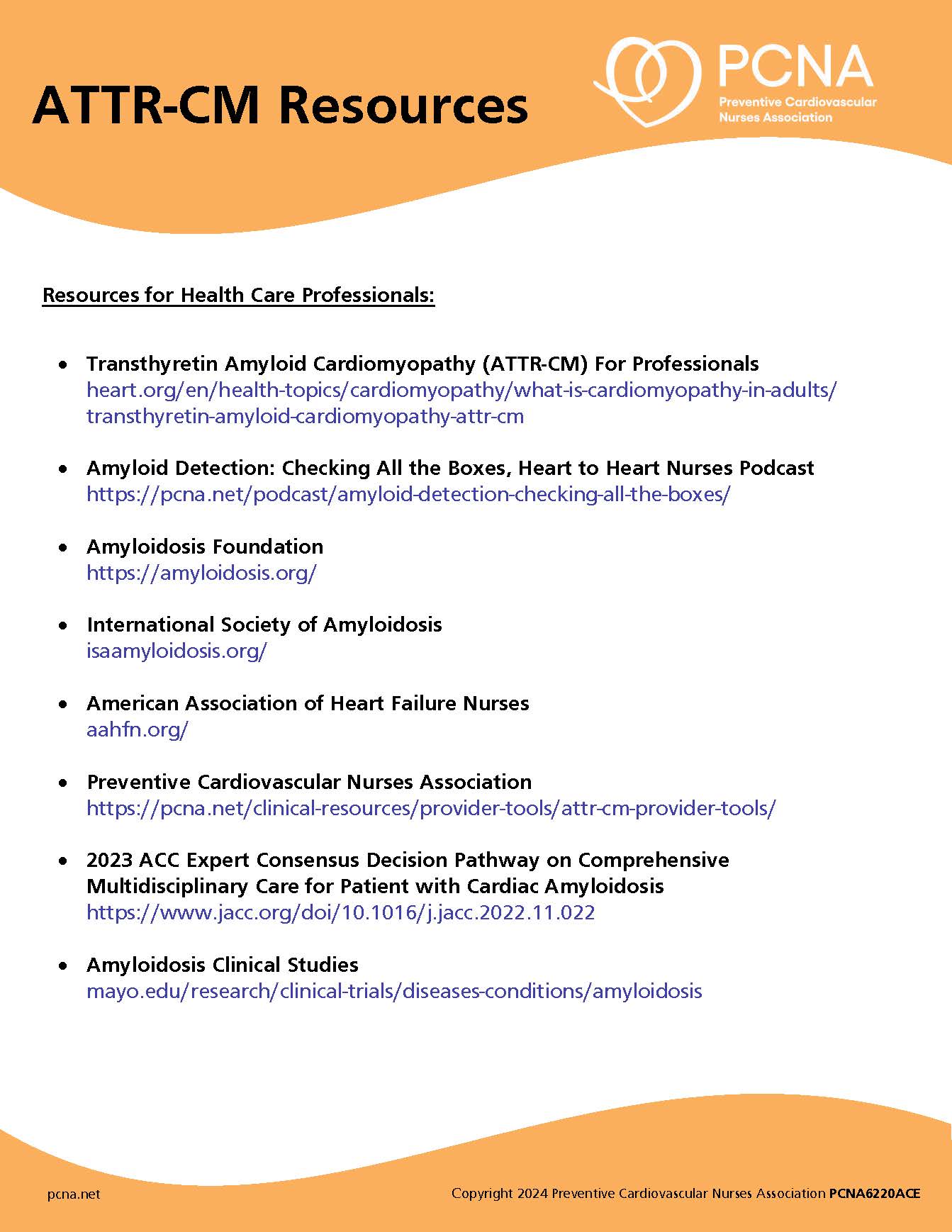Tune into a conversation between Cindy Bither, ACNP-BC, ANP representing the Preventive Cardiovascular Nurses Association (PCNA) and Ashlee Davis, BSMI, ACS, RDCS, FASE representing the American Society of Echocardiography (ASE) as they discuss the overall importance of echocardiography in diagnosing Cardiac Amyloidosis. Explore the team-based perspectives from the speakers as they dive into when to order an echo, what to include in the echo order, and when to use Strain imaging.
Content and messaging for this podcast was developed by PCNA with support from Pfizer Inc.
Episode Resources
- PCNA Amalydosis Provider Tools
- PCNA Amalydosis podcast episodes
- AAHFN Podcast
- AAHFN Manual: A Guide for the Diagnosis and Management of Amyloidosis
- ASE Resources on Echocardiography and Amyloidosis
Welcome to Heart to Heart Nurses, brought to you by the Preventive Cardiovascular Nurses Association. PCNA’s mission is to promote nurses as leaders in cardiovascular disease prevention and management.
Geralyn Warfield (host): [00:00:00] This podcast is created in partnership with the American Society of Echocardiography. ASE’s mission is to advance cardiovascular ultrasound and improve lives through excellence in education, research innovation, advocacy and service to the profession, as well as to the public. This podcast is for US healthcare professionals only and has been supported by Pfizer. This activity is not certified for continuing medical education.
In today’s episode, we are going to focus on the detection of Transthyretin Amyloid Cardiomyopathy, which is also known as ATTR-CM. Today I’m joined by Cindy Bither, Nurse [00:01:00] Practitioner, and Ashlee Davis, Sonographer. Cindy, could you introduce yourself, and then we will have Ashlee introduce herself as well?
Cindy Bither (guest): My name is Cindy Bither. I am the Chief Nurse Practitioner for Advanced Heart Failure at MedStar Washington Hospital Center in Washington, DC, and also one of the past presidents of the American Association of Heart Failure Nurses.
Ashlee Davis (guest): And I’m Ashlee Davis. I’m the Chief Sonographer at the Cardiac Diagnostic Unit at Duke University Hospital. I have a research interest in cardiac amyloidosis and specifically in strain imaging and patterns.
Geralyn Warfield (host): Well, I’m sure our audience can tell already that we have some great professionals on the podcast today and a unique opportunity for us to explore the interdisciplinary perspective with their healthcare experience. So, let’s get started. Cindy, could you share a description of amyloid and what clinical indications would prompt you to consider ordering a rule-out echo?
Cindy Bither (guest): So, amyloidosis is a disease that [00:02:00] encompasses many, many organ systems, and that’s the difficulty in diagnosing it. We have patients that come in with all sorts of symptoms, and a lot of times we send them to other practitioners to get looked at for these symptoms, but in actuality, they are all one disease.
So, some of the primary things that we see, and let’s start with the cardiac since that’s what we’re mainly focusing on, is that they get a lot of arrhythmias. They get a lot of conduction abnormalities, as well as that they develop heart failure. They have left ventricular hypertrophy with the caveat being that on their EKG, the voltage is actually low, when normally with left ventricular hypertrophy it’s high.
They have a tendency to develop a heart failure with volume trouble, quite frequently. They have to be diuresed and on a very tight regimen. But at the same time, if you diurese them too much, they’re very [00:03:00] sensitive to that and they decompensate quickly.
But other issues to look at that we commonly forget to ask about, because it’s not a common cardiac workup, is things like carpal tunnel syndrome. If you’re right-handed, but you’ve needed carpal tunnel surgery to both of your wrists, that’s not usual, as well as having issues such as spinal stenosis.
Orthostatic hypotension is very common but can be tuned into a lot of the different drugs that they use. A lot of the autonomic symptoms such as chronic diarrhea, Lord knows I don’t want to work that up in my cardiac clinic, but we have to be very attuned to that. And then other things like difficulty walking, sometimes peripheral neuropathy to the point where they’re having so much trouble ambulating and taking care of themselves that they become eventually wheelchair bound.
So, we can’t just look at one system to diagnose this disease. We [00:04:00] have to actually do a full history and physical, And I must say, since focusing on this patient population over the last couple years, I’ve become a much better nurse practitioner because I actually have to be more comprehensive in taking care of the whole patient. I think, if we have to talk about amyloid when I go look for a workup, I would take multiple symptoms and start to try to put it together and think, “Hmm, now I need to start my workup.”
The most important part of the workup being to rule out AL Amyloidosis—the one that comes from the bone marrow, because that is a deadly disease and it’s, it’s really one that you need to diagnose quickly and get it taken care of very quickly because people die very quickly of that disease. The hereditary disease is much more drawn out. The symptoms can be present for many years before it actually comes. But one of the [00:05:00] first things I would do is probably send my patient for an echocardiogram and then start the lab and diagnostic workup, the simple things, not the invasive ones, just to get a grasp of what the patient looks like.
Geralyn Warfield (host): So, Ashlee, if there’s a clinical suspicion of amyloid, what can echocardiography do to help those individuals that are working in cardiovascular practice to find out more information?
Ashlee Davis (guest): So much like Cindy was talking about with the constellation of symptoms that a patient might show, the echo presentation can also be very similar to a lot of other diseases that we see. So, left ventricular hypertrophy may be seen in a lot of other things such as hypertension, aortic stenosis, other in infiltrative cardiomyopathies. These patients also present with diastolic heart failure and enlarged left atrium, enlarged volumes, thickened leaflets. So, there’s a lot of [00:06:00] things that we’ll see on the echo that we may see commonly otherwise.
But the important piece is piecing them all together and knowing the patient’s history. And knowing if the LVH is there, do they have hypertension? And if the answer is no, you may want to continue to work up or look for other amyloid-type presentations on the echo. So, the most common things we see are LVH, RVH, but not explained by other disease states, by atrial enlargement, diastolic dysfunction, reduce, reduced annular velocities, maybe a pericardial effusion, they can have valve thickening, that’s not otherwise explained. And one of the big things that we look at recently is a preserved left ventricular ejection fraction with reduced global longitudinal strain. And strain patterns can be a real key and sort of the capstone to the echo to move forward on [00:07:00] pursuing an amyloid diagnosis.
Geralyn Warfield (host): So, the field of amyloid detection has changed quite a bit over time. Cindy, I’m wondering if you could tell us just a little bit about the changes you have seen in your career.
Cindy Bither (guest): Well, I’ve been a nurse for 42 years with the last 28 of them as a nurse practitioner, and I’ve done heart failure the whole time. And I have to say that when, at 28 years ago, when I would meet a patient that has been diagnosed with amyloidosis, it was probably, mostly, a call to the hospice team because by the time we met them and had they had the heart failure symptoms they would have about a six-month prognosis. There was nothing to offer them and nothing we could do. And it was a very hard time and very hard patient population to take care of.
Now I’m excited. Now we have options for patients. Things that we never had before, and so now when you meet them the goal is to make them understand that we can slow down this progression, that we can make their quality of life [00:08:00] better, and this doesn’t have to be the disease that potentially their relative died from, that they watched a very painful death that we now have hope.
Geralyn Warfield (host): Ashlee, do you have anything from your expertise that you’d like to add?
Ashlee Davis (guest): Yeah, from the Echo perspective, we’ve seen a lot of increased interest and research around amyloid and even just over the last few years with global longitudinal strain patterns developing, we can actually find these patients earlier. Before we would see a patient like Cindy was seeing and call it an infiltrative cardiomyopathy and not really have a lot of detail around it. And now we can help work together to figure out if it’s amyloid and get the patient the right treatment. So, I think there’s a lot more interest around the patient’s detailed echo report in an infiltrative cardiomyopathy rather than just a generic term.
Geralyn Warfield (host): Ashlee, could you please tell us a little bit about, from the echo [00:09:00] perspective, what red flag should we be looking at there?
Ashlee Davis (guest): Sure. There’s a lot of things on an echo that you may see in other diseases. So we can see a patient that has amyloid maybe has LVH, or RVH or bi-atrial enlargement, diastolic dysfunction, reduced annual velocities, things that we’ll see in other disease states, but the key is we’re looking for those things combined in a constellation and also not otherwise explained. So, if a patient has LVH but doesn’t have hypertension, and has no other explanation for bi-atrial enlargement or valvular thickening, that can really help us clue into something else is going on underneath, you know, it could be amyloid or other infiltrative cardiomyopathies.
And then also using global longitudinal strain. Global longitudinal strain can really show us amyloid’s specific patterns, [00:10:00] that can help us combine with those other echo findings to kind of lead us down the right path to make sure that patient gets the diagnosis or gets other tests that need to be done that may indicate they have amyloid.
Geralyn Warfield (host): For our clinicians in the audience, what kind of instruction do we need to make sure that we get that echo that we’re looking for to actually rule out amyloid?
Ashlee Davis (guest): That’s a great question. If you suspect amyloid for any of the clinical reasons that we’ve stated already, it’s important that you spell that out on the echo order. You know, putting something simple like rule out amyloid, or suspicion for amyloid, something to that effect so that the sonographer doesn’t have to do a lot of digging to figure it out and know exactly what you’re thinking and looking for.
Sometimes people will put things like infiltrative cardiomyopathy or, you know, history of certain type of cancers and think they’re relaying that they’re looking [00:11:00] for amyloid. But I think it’s really important if you’re suspecting amyloid to go ahead and put it in the echo order. If amyloid is not spelled out in the echo order and the sonographer starts to see some of these things and piecing it together while they’re performing the echo, they can also add on strain and look into it themselves.
And sometimes the stenographer is the one to piece it together and relay that information back to the reading physician and the ordering physician to have that patient go down the workup for amyloid. So it can work either way, but it’s really important if you’re suspecting amyloid to spell it out in the order and make sure that you get the echo that you want. You may also want to include strain as part of the echo order. So, in your institution you may write amyloid echo, please perform strain, so that the sonographer knows that you want strain performed on that echo.
Geralyn Warfield (host): We’ve been discussing amyloid detection using echocardiography with our guests [00:12:00] Cindy Bither and Ashlee Davis. We’re going to take a quick break and we will be right back.
Geralyn Warfield (host): We’d like to welcome back our audience to our discussion with Cindy Bither and Ashlee Davis about amyloid detection and the role of echocardiography. I’d like us to spend a little bit more time, right before the break, we talked a little bit about strain imaging and that may not be a term that our audience is familiar with. And I’m wondering if you could talk about the differences and benefits for us, Ashlee.
Ashlee Davis (guest): Sure. Strain, specifically global longitudinal strain, is an additional echo analysis that can be performed on our regular echo images with special software. And strain looks at the ability of the heart to contract in the longitudinal direction. So, this can actually pick up abnormalities in the heart that we can’t yet identify with our eyes. Strain is fairly simple and a quick way to add loads of additional information to an echo. And it can be extremely helpful in [00:13:00] the assessment for amyloid.
In amyloid, we’re looking for reduced strain values, especially in the setting of a normal ejection fraction. And we can often see a specific strain pattern known as apical sparing, or the cherry on top, and piecing these strain clues together with the other echo parameters we spoke about earlier, can really benefit the reader and piece together the clinical picture to help get the patient to the diagnosis faster.
Cindy Bither (guest): So, Ashlee, this is Cindy again. I have a question for you. I have a patient that has had chronic HFpEF diagnosis for years. And, unfortunately, I’m seeing her kind of late in this process. So, she’s been diagnosed for about six or seven years where she’s had, they just assumed it was heart failure with preserved ejection fraction. So, she’s now coming in and when I dig in a little deeper using my history and physical skills, I’m finding out that [00:14:00] she’s had a couple of other signals that make me concerned that this is not just HFpEF. She’s had some carpal, bilateral carpal tunnel surgery. She’s got some numbness in her feet and she’s not a diabetic. How can this really help me discern what, if, this patient really still does have heart failure with preserved ejection fraction, or, if it’s still HFpEF? And is this something that you could really help me with?
Ashlee Davis (guest): Cindy, that’s a great example. We see this very often, especially in the last few years and the last few months, as people have amyloid more in the forefront of their minds. And as amyloid diagnosis has increased, people are paying attention to it more and piecing this together. So, I think getting another echo with the specific question, for amyloid, would be really important. Especially if the patient didn’t have strain imaging on the prior exam. We can perform that, look for that cherry on top, apical [00:15:00] sparing pattern. Especially as amyloid progresses, that pattern will become more obvious.
So, maybe her prior echos didn’t have significant LVH or some of the thickening of the valves or bi-atrial enlargement may not have been as obvious. As she progresses, it may become more obvious on the echo, and knowing what we’re looking for is really helpful so that we can make sure and provide the echo reader, and you as the ordering provider, with all of the pieces together. So, we’ll take special attention to do really good measurements of the LV wall thickness, RV wall thickness. Make sure and optimize to measure the left atrial size and diastolic function. And like I said, make sure that we get strain, especially if it wasn’t performed prior and look for those strain patterns. If her ejection fraction is still preserved and we’re calling her, normal EF, [00:16:00] HFpEF, then her strain values may be reduced and that can also clue you into something’s going on with the myocardium that we’re not seeing visually yet with her ejection fraction.
Cindy Bither (guest): I also work in a community clinic, so I split my time to an outlying clinic for MedStar. I don’t know that they do strain at some of the outlying clinics. Is it pretty common now or is this something that I have to specifically hunt around for?
Ashlee Davis (guest): So, strain is available on most modern echo machines as an option, but it is an add on application, just like an application on our iPhone. You know, we may not all have the same apps. That’s the same thing with an Echo machine. So, if the strain package wasn’t purchased or wasn’t available all machines may not have it. So, that’s really something important to know if you have the option. You know, [00:17:00] sometimes we send patients to specific clinics because they have special machines or special software available. So that would be really important for the clinician to know.
[It] doesn’t mean that the echo is going to be useless if we do it without strain. There’s a lot of the other parameters that we can help you piece together, like the diastolic dysfunction, LVH, things like that. But it is important to know whether strain is an option at that location.
The other piece is the training. So if strain is available, but the sonographers or the readers are not yet very comfortable with it or haven’t used it a lot, training may be a piece that needs to happen at each of those locations. And strain is fairly user friendly, but there are some technical aspects to it that can affect whether you get the appropriate pattern, whether it’s easy to [00:18:00] recognize that pattern and different strain software levels can also affect whether that pattern shows up on the echo. So, whether strain is available or not, what software it is, and what software level, is all really important and can affect whether you get the additional information that you’re looking for.
Cindy Bither (guest): I When I look at the red flag symptoms for an amyloidosis patient, it really makes me be a better practitioner. It’s very multisystem. And it’s very subtle sometimes. And so, you have to know the right questions to ask and the right symptoms to look for.
When I look at a patient and I’m looking for red flags, one of the things, especially because I’m in a cardiology clinic, is LV hypertrophy. And especially in the patient that has an EKG that shows low voltage because they should have high voltage with left ventricular hypertrophy. I also [00:19:00] look at patients that have a lot of arrhythmias, have conduction abnormalities with no known cause, and also for patients that have heart failure, that have HFpEF, a disease that we’ve just treated over the years with fluid and not gone much further in many cases.
But you, you can’t just stop there. You have to look for other symptoms, other red flag symptoms. If somebody is right-handed and they use their right hand a lot, then they get carpal tunnel in, usually, that hand. But if they have bilateral carpal tunnel syndrome and they’re not using both their hands, that’s abnormal. And so, this person, there’s no reason for them to have carpal tunnel in their non-dominant hand. So that is a red flag.
As well as people who have orthostatic hypotension for no reason. I also look for patients that have diarrhea, not something that I usually ask a question for when they come to my clinic, but I have to ask that now because chronic [00:20:00] diarrhea may not be something they want to talk about, but it’s something that I need to know about. As well as other things like numbness and tingling if they’re not a diabetic. That also is very uncommon. And altered sensation, weakness for no reason and difficulty walking. Those are all things that are red flag symptoms and I have to change my H&P, as we say in the hospital. Or in the clinic, I have to change my questioning of the patient when they arrive as a new consult to try to find out if there’s more to their story than just heart failure.
So, Ashlee, in the clinics that we have today, there are a lot of patients that have HFpEF. There are a lot of patients that have stiff hearts and thick hearts, and we treat them. Would it be overwhelming to the system if I wanted to refer every patient that I have with LV hypertrophy to get another echo with strain imaging?
Ashlee Davis (guest): Depending on [00:21:00 ] the patient load, that may be a lot to ask of an Echo lab. However, I think there are a lot of, most of what we’re talking about is found on your normal echo. The Echo report that we’re getting for all heart failure patients. So, most of what we’re talking about is already there. The piece that would be the additional piece that may not be performed on every patient, is the strain. So, I think if you’ve gotten an echo, and you’re highly suspicious of amyloid and all of the other pieces are there on the echo report, you know, if they have LVH, they have diastolic dysfunction, they have all these things, and you have a clinical suspicion, it’s not unreasonable to ask for strain on that patient.
I think that using your tools smartly and making sure that you’re getting that on the patients that actually need it is important. And if that means we go back and do strain on the echo that’s already been performed, that may be an option for different labs [00:22:00] depending on how they have it set up. Or repeating a few pictures for strain analysis. You know, if that gets the patient to the right diagnosis quicker and they don’t have to go to another more invasive test, or even a biopsy, then by all means send them back to the Echo Lab.
And I think developing that relationship with your Echo lab where you have it on your mind, you’re communicating with them on the front end, will get everybody to the diagnosis quicker, to the patient treatment quicker. But there’s a lot of times we put the pieces together later and sometimes you’ll get the Echo report and that’ll clue you in to, “Maybe I should look for amyloid on this patient.” And in that case, I think its important and you know, it’s in the best patient’s best interest to go back and get the strain on that patient. So that’s definitely not unreasonable.
Geralyn Warfield (host): So, the goal of having a rule-out, or in this case perhaps a rule-in, amyloid kind of echo, is really so that we can [00:23:00] determine for our patients where they are, whether or not they have amyloid, whether or not they don’t. And from a clinician perspective, Cindy, I’m wondering if you can tell me, what kind of timeline you see in your clinic setting in terms of what it takes for them to get that actual amyloid diagnosis? Is it always about the same? Have you seen some impacts from having these rule out amyloid cardiography sessions? I mean, what kind of experiences have you had?
Cindy Bither (guest): Well, I have to say that, well, if I go back to the beginning of my career, 28 years ago starting off as a nurse practitioner in advanced heart failure, at that point, amyloid was pretty much where you called hospice and you had to let them go.
Now that there’s treatment for amyloid, which has made a world of difference to the patients, we’re all a little bit more attuned to it because we now can do something about it. It’s still in some [00:24:00] instances, a very long process for these people to get a diagnosis. We’re treating their symptoms, but we’re not finding the diagnosis till it’s late. And we’re not getting them on therapy early enough.
If we can get these patients on therapy before they are in a NYHA Class Four and a heart failure Stage D, then they can have a much better quality of life. We need to stop the progression of the disease, the infiltration of the amyloid proteins into the heart muscle, just so that people can have a better quality of life. So, I must say that we are much more attuned to it. We’re trying to train our residents and new nurse practitioners that are coming out of our program to be attuned to it also so that our patients get a better quality of life.
And when we find it in patients, we actually will send back a letter to the referring to try to help them see why we thought about it, as so that they can [00:25:00] also be looking at their patients as they come through their clinics so that they’ll think about it and send them earlier. We don’t need them to do the work-up. We can do the work-up. Just think about it. Just think about it so that we can get started. That is what brings longevity and better quality of life, and that’s what’s important.
Geralyn Warfield (host): And Ashlee, are you seeing from the echo standpoint, are you seeing more awareness of amyloid in your setting as well?
Ashlee Davis (guest): We are. We have a really great amyloid program here, so it’s definitely been brought to the attention of our providers to think about it and send it to the amyloid-specific providers to think about.
But also in the echo world, since we’re doing strain on most patients, especially patients with LVH, that’s unexplained or a cardiomyopathy with a decreased EF, we’re also seeing the strain pattern before the [00:26:00] provider has asked for it. So, it goes both ways. I think we can also be a frontline defense by looking for these things on the echo. And just like the clinical workup, you’re looking for unexplained constellation of things on the echo.
So, if there’s LVH and you don’t know why, or, you have LVH and RVH, or you have all three things put together, piecing that together. And then doing the strain and looking for that strain pattern, sometimes we can be the first line of defense to send it back to someone who hasn’t even thought of it yet. And that’s really rewarding because, like Cindy said, there’s options for these patients now. So, it’s even more important. Before it was of interest and we would send it back and, you know, think it was kind of an unfortunate diagnosis. And now there’s actually options. So, finding these patients early.
So, as sonographers we can also [00:27:00] be detectives and we’re talking to the patients asking them about their symptoms. “How did you get here? You know, what’s going on? What other symptoms are you having?” Like carpal tunnel, if they mention that. Or just unexplained heart failure. Or the mismatch between a normal ejection fraction, heart failure symptoms and abnormal strain values. So, I think we’re all working together as a team and whoever picks it out first, then we can work together to get that patient moved through. So, it may be the clinician ordering it the first time, or it may be the sonographer actually doing the exam.
Geralyn Warfield (host): I really appreciate the fact that you’ve talked about it, as it’s a team-based effort and it’s so important that everybody has as much information as possible available to them so that they know what to look for, how to access maybe some testing and those types of things.
So, the next little piece that we’re going to talk about is just about resources. And I’m going get us started with [00:28:00] just some quick resources that the PCNA has. We have a series of three additional podcasts that you can access on the Heart to Heart Nurses podcast series. You can also find information on a recent PCNA and ASE video that breaks down the Echo report for the non-echo experts. And also, the American Association of Heart Failure Nurses has a podcast and a manual as well.
So those are just a few places and we will make sure that we put all of these resources in the show notes. If you are looking for that information, you’ll have a real quick resource for that. But Cindy, what other resources might you point our listeners towards?
Cindy Bither (guest): So, the main thing, besides the things that were listed is that there are educational opportunities everywhere. There’s a lot online especially from all the, the companies that are coming out with these new medications and ways to know to look for [00:29:00] the red flag symptoms. And I think, one thing that the AAHFN put together, and you already mentioned that was the manual, and I recommend that one highly just because it’s a comprehensive guide to amyloidosis. Not only cardiac amyloidosis, but also the other organ systems. That can be found on the AAHFN website.
Geralyn Warfield (host): Ashlee, how about you? Do you have any resources that you would point folks towards to learn more about this particular topic, which is of great import?
Ashlee Davis (guest): I do, especially for the sonographers, or those who are interested in echo for amyloid. There’s a great webpage on the ASE main page that is linked. If you go to asecho.org/cardiacamyloidosis. There it links to a short video on kind of what we’ve been talking about diagnosis, or suspicion to diagnosis, using echo. [00:30:00]
There’s some on demand webinars. The Basics of Cardiac Amyloidosis: Pearls and Pitfalls of imaging. Read with the Experts, challenging cases with amyloid, which is really interesting to see real-life cases and how they came about. So that page has tons of information, guidelines and articles, and interesting case studies.
And then there was also a recent publication in the September issue of the Journal of American Society of Echocardiography called Practical Points for Echocardiography in Cardiac Amyloidosis. It’s a simple read. It’s a quick read, but it hits all of the highlights as far as what to look for in echo, what Echo could actually show you, and how to optimize your echo in order to assess for cardiac amyloid. So as a sonographer or as a manager for the Echo Lab or an [00:31:00] echocardiography reader, any of those people would find this extremely helpful. And also, other clinicians that just want to know, “What am I asking for of the Echo Lab when I ask for this echo?” That can really, they can read that, and it’ll give them a good, good idea of what to look for on the Echo report.
Geralyn Warfield (host): Is there anything else that either one of you would like to add that we’ve neglected to discuss thus far?
Cindy Bither (guest): I do think I’d want to add one thing. There are some where you really feel that they have amyloid. And the echo may not, at this point in their diagnosis, be diagnostic. I don’t want you to forget about it. You may want to go further and get a biopsy. It is not 100% accurate. It’s close. And Ashlee may know the statistics, but I do know that there have been some patients that, you know, it just “smelled” like amyloid and you have to dig further and you hopefully at that point would come to a [00:32:00] conclusion.
Ashlee Davis (guest): Yeah, that’s a great point, Cindy. You know, there was a paper out of Cleveland Clinic that showed echo in this apical sparing pattern, to be about 93% sensitive and 82% specific in differentiating amyloid, but that’s not 100% percent. So, there’s patients there that we may miss if you don’t use your clinical suspicion and keep going.
So, there’s also some technical aspects to doing the strain, or, certain vendor types of software levels that may make it more difficult. So use your clinical skills and keep going and, you know, if you really feel like it could be amyloid, you know, keep going and advocating for that patient and take the next step and figure it out.
Geralyn Warfield (host): We are so very grateful to our guests, Ashlee Davis and Cindy Bither, for taking a walk through amyloid detection and how we all have a responsibility to know a little bit more and to apply that into our practice [00:33:00] wherever it is that we are working.
We’d also like to thank Pfizer for their support for this particular podcast episode.
You can find the resources on the show notes, and you can also find them at pcna.net and ase.org.
This is your host, Geralyn Warfield, and we will see you next time.
Thank you for listening to Heart to Heart Nurses. We invite you to visit pcna.net for clinical resources, continuing education, and much more.
Topics
- Cardiomyopathy
Published on
November 15, 2022
Listen on:
Related Resources

Videos
A Nurse to Nurse Conversation on Hypertrophic Cardiomyopathy and Shared Decision-Making Video
January 19, 2025









